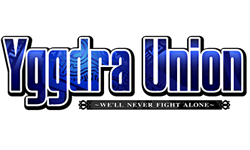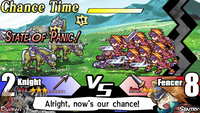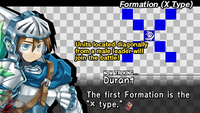|
|

|
PLATFORM
|
PSP
|
BATTLE SYSTEM
|

|
INTERACTION
|

|
ORIGINALITY
|

|
STORY
|

|
MUSIC & SOUND
|

|
VISUALS
|

|
CHALLENGE
|
Hard
|
COMPLETION TIME
|
40-60 Hours
|
|
OVERALL

|
+ Well-paced story
+ Interesting, likable characters
+ Engaging battle system
- Difficulty can be upsetting
- Criticals highly overpowered
|
Click here for scoring definitions
|
|
|
Originally released for the Game Boy Advance at the end of the system's lifespan, this tactical RPG gem didn't garner nearly as much attention as it deserved. Though hobbled by a sharp difficulty curve, those players that got through the game were rewarded with a rich story, engaging characters, and interesting battle mechanics. Now released two years later for the PSP with additional content, Yggdra Union: We'll Never Fight Alone is a delightful romp for both new players and those that enjoyed (or slogged through) the original foray. With additional battles, a new storyline, optional characters, and variable difficulty levels, the more irritating flaws of YU are smoothed out, resulting in a fantastic game.
Ready, set, shuffle! Well, not quite, but cards are the basis of this tactical battle system. At the opening of battle, the player chooses a number of cards which vary by battle. There are thirty five cards total to find in the game, up from the thirty found in the GBA version. Cards have four important factors: Power, Movement, Ace, and Ability. The power of a card dictates how much damage is dealt when Yggdra and her allies win, and how much damage is received when they lose. The more powerful a card, the more it protects against a loss. Movement determines how many spaces Yggdra's entire team can move in a round. For example, if a card has ten movement, one character could move ten spots, or two or more units could split the movement, as long as it adds up to no more than ten. Ace determines who can use the ability of the card, and can either be a specific weapon (such as a sword) or marked as All. Each card has an ability which can be activated in battle once the charge meter has filled. These abilities can only be activated when the leader is the correct ace and may have restrictions such as time of the day, but don't dismiss their power: several cards acquired in the latter half of the game are incredibly powerful and can turn the tide of nearly impossible battles.
Once units and cards are selected at the start of a battle, one card is chosen per turn until Yggdra has no cards (a loss) or the goals for the map have been completed. Long battles will generally refund Yggdra's used cards, so the player will rarely run out of cards. Most players will end up having a set of five to ten 'favourite' cards that will be built up in power with an additional five to ten reserved as 'movement' cards that have questionable power or ability but high movement. But, as the player advances through the game, more complicated facets of the combat system -- such as the Union System -- become available. Allies can be introduced into battle from up to two spaces away depending on the lead attacker's formation: males seek allies in an 'x' pattern, while females use a '+' to determine who fights with them. Later, additional formations are added where each allied unit uses its own formation to seek allies. It sounds complicated but is displayed on screen when it occurs. For example, a male character starting a combat will grab a female ally one space up and to the left of him, and she in turn will bring an ally standing to the right of her.
 Durant hit with a critical
Durant hit with a critical
|
|
Before entering combat, a player should heed weapon strengths and weaknesses. At first, basic weapons are introduced: swords trump axes, axes trump spears, and spears trump swords. Rods trump basic weapons, bows trump rods, and basic weapons trump bows. Two special categories stand outside these circles: scythes trump basic weapons but are weak to nothing, and lump (summoned mobs) are weak to nothing but rod. While these weaknesses are critical during the first half of the game, they become less so as the game draws to a close. Either way, taking the battlefield is only the first step: once combat begins, a new screen comes up to focus on the combatants. An ally army will be on the left, the enemy on the right, with small units beginning with eight troops and large units beginning with four beefier ones. The aggressor will get an opening blow and the opponent may counter, but take note: bows do not counter and cannot be countered. After that, the two sides battle back and forth with their remaining troops until one side or the other runs out of units and is defeated. A player can "push forward" to empty their meter but do additional damage, or "hold back" to do less damage but prepare to use an ability. For the impatient, combat can be hastened by tapping the right shoulder button and the seriously impatient can look forward to hyper speed, which is unlocked by defeating the game. Rarely, a critical will immediately disable the unit's leader, almost always leading to a loss. Morale damage is assessed based on card power, and is boosted by certain conditions: the number of units remaining on the winning side and whether the general is alive--two conditions which boost damage. When a unit runs out of Morale, they are removed from the battlefield. When an ally falls, it is called a Zero Reset, and all progress to the next level is zeroed out and must be regained. The maximum level for an ally unit is twenty.
The graphics have been tidied up since the GBA days and look sharp and colourful. All the graphics have also been formatted to the wide screen of the PSP, avoiding the feeling of "stretchiness" some remakes have fallen prey to. Their pixie charm hasn't been lost with the transition to the new handheld, and those charmed by the graphics the first time around will find this aspect remains the same. The music has also been stepped up and sounds nice and crisp. Unfortunately, this didn't change the one problem the previous game had, in that the combat music is still lacking in variety. The same song heard over a surplus of fifty maps does get old quickly.
One aspect of the PSP remake that has been considerably improved is the difficulty. The GBA normal mode is now unlocked after defeating the game and marked as hard. In addition, if the player fails a mission they may opt to 'retry' the map, retaining all card power and player experience (aside from zero resets); enemies will be generally easier and occasionally a little dumber. If a player continues to struggle, the difficulty of a map can be lowered three to four times before it bottoms out to the easiest setting possible; this is not a permanent difficulty change, but for that specific mission only. This allows the player to keep going, making small progress, until the game adjusts itself to the player's skill. Not all battles are equally difficult; there are several that will present a great challenge to the player. Factoring in the occasional retry, a typical player could finish the first round of the game in about forty hours, with those that seek to explore fully every map finding their clock ticking up over fifty hours or more, not counting additional replays.
As is to be expected from Atlus, the localization is very well done. Players have the option of listening to the Japanese voice actors or the English ones, and this setting can be changed at any point from the title screen. While the voice acting has a couple bit parts with some overacted moments, on the whole it's very well done and the main characters are all voiced incredibly well. All the text matches up with what the voiceovers are saying and the speech parts can be skipped at any time for the impatient. The rest of the localization including the interface is very well done; menus are simple to navigate, restoring and equipping characters is a quick and painless process, and cards can be sorted by card number, power, alphabet, and movement at whim. While in a mission, pressing the left shoulder button brings up a menu which can give the player important at-a-glance information such as weapon strengths and weaknesses, objectives, tutorials and other vital resources.
 Formations
Formations
|
|
Unlike most tactical RPGs where the story comes in large chunks between battles, YU injects the story right into the action by having multi-part battles. Each section is short enough to stay interesting while not disturbing a player's game-on-the-go. The game begins with only a couple of characters, but Yggdra's army can swell with up to a dozen generals, depending which optional characters are picked up along the way. All have some story attached to them that guides their actions. How the story is told only serves to showcase a seemingly simple story of a princess and a bandit that quickly ramps up to a war that threatens the entire world. Characters change and grow as the game progresses and it's hard not to sympathize with the tough choices Yggdra must make. Along with a couple of branching mini-stories, the game has two different endings as well.
As time passes, the standards for a remake rise and once in a blue moon a remake can end up being a shining game able to stand on its own. Many changes come with the new version of YU, a short list includes: adjusted difficulty, improved card levelling, elements on more weapons, additional characters, more levels, the ability to speed up battles and easily skip tutorials. Those who played the GBA version will find there's enough to rate a second look and newcomers won't feel quite as intimidated by the previous title's difficulty. Yggdra Union manages to stand up and be an excellent example of a game that manages to challenge a player without being completely crushing. Any TRPG lover would be proud to add this title to their vaunted collection.
Review Archives
|









